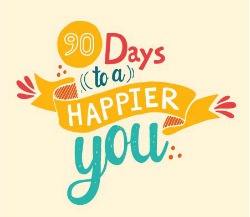As part of Live Happy’s special series 90 Days to a Happier You, we’ve gathered top experts from around the country with unbeatable advice about how we can change habits and live better in 2016. Below, as part of an ongoing blog series, expert coach Caroline Miller walks us through the steps of successfully setting short- and long-term goals.
Self-help books are popular for a reason: Research shows that more than 90 percent of us would like to improve something about ourselves. Fortunately, the research also shows that with diligence and evidence-based goal setting processes, we have much greater chances of achieving our dreams than if we just wing it and hope for the best.
Chris Libby, section editor of Live Happy, is a good example of someone who wants change, but didn’t know anything about the science of goal-setting, or the ways he might be hindering himself, until we started our coaching. Follow our journey—or better, join us by interacting with us—and together we will get a good look at how a step-by-step, scientific goal-setting method can help anyone get traction in life, regardless of where you start.
Here are the six steps we will take together in the 90-Day Challenge:
1. Capitalize on your strengths
 First, I recommend taking the VIA Strengths Survey. Studies have found that knowing your top strengths makes you happier—particularly when you have the opportunity to put those strengths to use in new and resourceful ways. If gratitude is a top strength, you might leave a hand-written thank-you note instead of sending an email, for example, and think up other ways to share your heightened sense of hope and appreciation.
First, I recommend taking the VIA Strengths Survey. Studies have found that knowing your top strengths makes you happier—particularly when you have the opportunity to put those strengths to use in new and resourceful ways. If gratitude is a top strength, you might leave a hand-written thank-you note instead of sending an email, for example, and think up other ways to share your heightened sense of hope and appreciation.
Homework: Write an essay called “Me at My Best.” Describe a time when you used all of your top strengths in a “peak moment,” or when others said you made a positive difference. This essay will serve as a blueprint of best practices for you as you go about setting your goals.
2. Create a daily happiness boot-up menu
Research has found that success in life is preceded by being happy first, and not vice versa. If we are going to flourish and succeed, we have to do things that elicit and amplify positivity on a daily basis. There are several “positive interventions” that improve well-being, such as physical exercise, practicing gratitude, doing mindfulness/meditation activities, volunteering/giving, journaling and practicing forgiveness.
Homework: Create or reinforce daily habits that increase your happiness levels, and use your strengths in doing so. For example, if “zest” is a top strength, add vigorous exercise to your day or use your energy to support someone else’s cause. If love of learning is a top strength, find ways to investigate new sources of education such as a virtual course or a TED talk.
3. Write about your "Best possible future self”
This elegant journaling exercise is deceptively powerful: Mentally project yourself 10 years into the future and write about your life as if everything has gone as well as possible. Do this for three days in a row, for 20 minutes at a time. Research finds that people who complete this exercise are more hopeful, more committed to their goals and clearer about priorities.
Homework: Pick at least one long-term goal that has emerged from this exercise and write down the short-term steps you are ready to commit to that are necessary to pursue this goal. Write about the obstacles that are likely to emerge as you pursue this goal and how you plan to handle them. How will you use your strengths to overcome obstacles?
4. Build a platform of psychological strength for change
To carry out the steps needed to accomplish goals, you must have inner stores of self-regulation and resilience. Without willpower or the ability to delay gratification, it will be impossible to do difficult things outside of your comfort zone, which is where many of the most meaningful goals lie. We will need resilience to get up every time we are knocked down, challenged or delayed, too, and grit will be the strength necessary to carry us to the finish line of the longest, hardest goals.
Homework: Take the Grit Scale test and reflect on your score. What are the hardest things you’ve ever done and how did you get yourself through them? If you don’t have a history of being resilient, how can you use your strengths to find ways to protect yourself from being pulled off-course?
5. Prime your environment for change
 Marketers know the science of “priming” and use it to help them sell products; sport psychologists use it to motivate athletes. We can “nudge” ourselves in subtle ways throughout the day, in every environment, by strategically putting pictures of our goals in places we are sure to encounter, by hearing songs that energize us, and by reading inspirational e-newsletters about successful people.
Marketers know the science of “priming” and use it to help them sell products; sport psychologists use it to motivate athletes. We can “nudge” ourselves in subtle ways throughout the day, in every environment, by strategically putting pictures of our goals in places we are sure to encounter, by hearing songs that energize us, and by reading inspirational e-newsletters about successful people.
Homework: Scan your daily environment for “negative primes” that might be de-energizing. Replace pictures, driving routes, television habits or clothing with items that will inspire and motivate you. Consider replacing at least one computer password with a phrase associated with an important goal or a character strength that you want to embody.
6. Create a positive team
Many people underestimate the undermining power of being surrounded by family, friends, co-workers and acquaintances who don’t support their positive change efforts. Social contagion theory states that we “catch” moods from those around us, including loneliness, depression, happiness and even grit. Other research connects “active-constructive responding” (marked by curiosity and enthusiasm) with friendship qualities that assist in proactive goal pursuit.
Homework: Create a “Web of Influence” document, with you at the center and those closest to you radiating outward. Do the qualities of those in your web match what you need to remain committed to change? If not, what can you do to deliberately pull other, more positive, people closer to you to be cheerleaders or even members of a “mastermind” group that you can create?
Read Caroline's second blog here, and her final blog here.
To see Caroline's recommendations in action, read coaching "subject" Chris Libby's blog, here.
Want more? Listen to Caroline discuss Setting Career Goals on our podcast, Live Happy Now.
Caroline Adams Miller, MAPP, is a professional coach, author, speaker and educator. Her book, Creating Your Best Life, is the first evidence-based book to connect the science of happiness with the science of goal-setting. Caroline gave an acclaimed TEDx talk on grit in 2014, a topic she will cover in her upcoming book, Authentic Grit.















